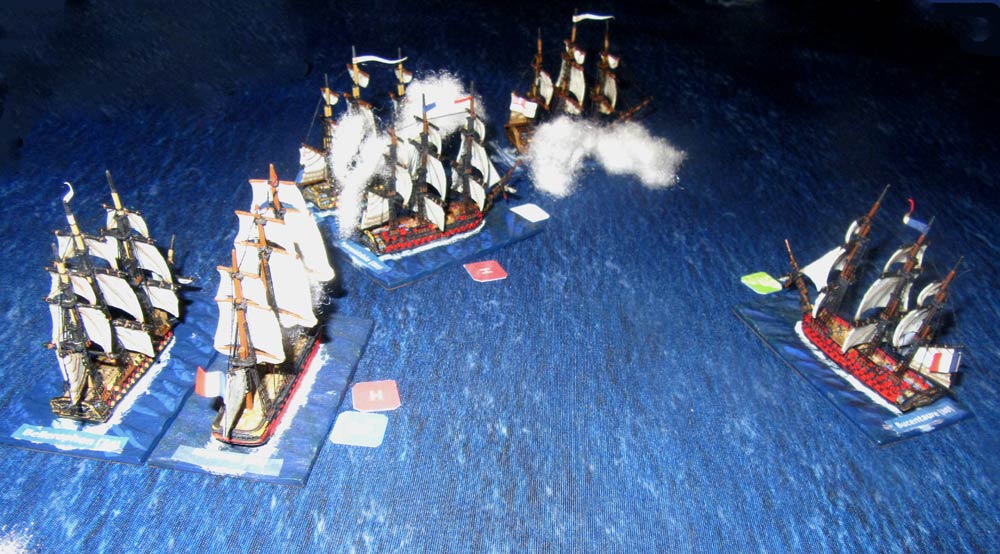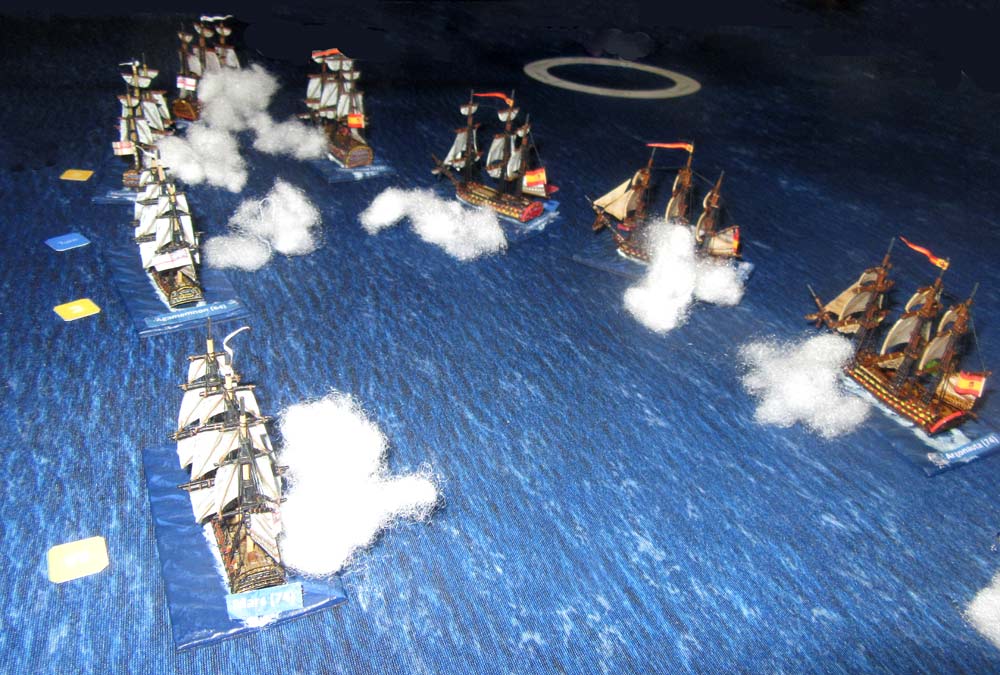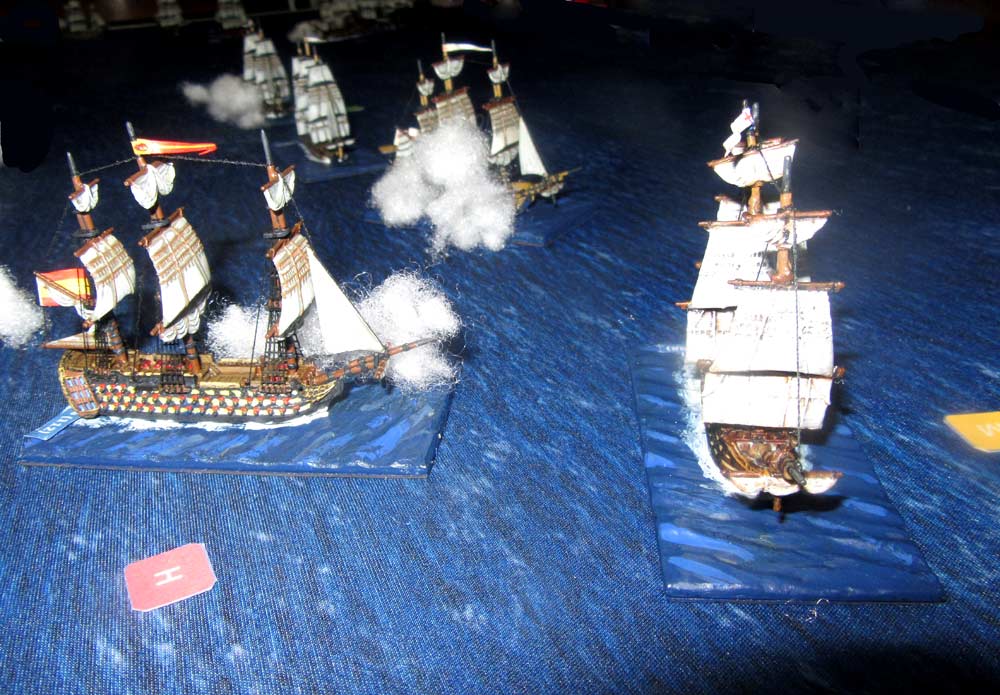
Action off Cape Palos, 1805
10th February 2022, 5 Comments
The Age of Fighting Sail, Far Distant Ships, 1/1200 scale
Last Trafalgar Day we played a Napoleonic era fleet action using Osprey’s Fighting Sail rules. I thought they were quite fun and fast to play, but I had quite a few reservations about them. The amendments posted on the rules’ Facebook page helped, but they still seemed very “Hollywood”. Then, David Manley sent me a PDF of his own fast-play rules for the period. If you want to check them out, they’re available online from the Wargames Vault – the PDF is a real bargain at just £7.50. Anyway, I brought my sailing ships out again, but this time we used David’s rules. Ostensibly the game was set in the Med off Cartagena in the year of Trafalgar. The idea was that a five ship French squadron had linked up with five Spanish ships from Cartagena, and together they were heading off to join the Franco-Spanish fleet at Cadiz. However, lurking off Cape Palos was Vice Admiral Collingwood with eight British ships-of-the-line.
Anyway, I brought my sailing ships out again, but this time we used David’s rules. Ostensibly the game was set in the Med off Cartagena in the year of Trafalgar. The idea was that a five ship French squadron had linked up with five Spanish ships from Cartagena, and together they were heading off to join the Franco-Spanish fleet at Cadiz. However, lurking off Cape Palos was Vice Admiral Collingwood with eight British ships-of-the-line. In this game, Nick (Vice Admiral de Pelley) commanded the French, Chris (Vice Admiral de Alava) the Spanish, while Sean and I each had a small British squadron under our wing. Chris and Sean were in charge, as they had the fleet flagships, de Alava’s Santa Anna (112 guns) and Collingwood’s 100 gun Royal Sovereign. The other squadrons were led by the French Formidable (80 guns), and my Temeraire (98 guns), under Commodore Freemantle. All the other ships in the game were Third Rates, the smallest being the 64 gun Agamemnon. We played the game on a 6 by 4 foot table.
In this game, Nick (Vice Admiral de Pelley) commanded the French, Chris (Vice Admiral de Alava) the Spanish, while Sean and I each had a small British squadron under our wing. Chris and Sean were in charge, as they had the fleet flagships, de Alava’s Santa Anna (112 guns) and Collingwood’s 100 gun Royal Sovereign. The other squadrons were led by the French Formidable (80 guns), and my Temeraire (98 guns), under Commodore Freemantle. All the other ships in the game were Third Rates, the smallest being the 64 gun Agamemnon. We played the game on a 6 by 4 foot table.  De Alava and Freemantle’s squadrons were in the lead, followed by the squadrons of de Pelley and Collingwood. The Franco-Spanish had the weather gage, and Nick took advantage of this from the start. He turned his squadron in succession to larboard, and headed towards the wide gap between the two strung-out British squadrons. Chris and I were content to slowly close the range, firing as we went. We both opened up at medium range, but the gap narrowed steadily, until we were battering it out at close quarters.
De Alava and Freemantle’s squadrons were in the lead, followed by the squadrons of de Pelley and Collingwood. The Franco-Spanish had the weather gage, and Nick took advantage of this from the start. He turned his squadron in succession to larboard, and headed towards the wide gap between the two strung-out British squadrons. Chris and I were content to slowly close the range, firing as we went. We both opened up at medium range, but the gap narrowed steadily, until we were battering it out at close quarters.  That was when things got really interesting. My British ships began to inflict light damage on the leading Spanish ships, o the leading Spaniards, but my flagship and the Thunderer (74) astern of her suffered too. In this trial game we were playing the basic rules, so our captains couldn’t repair damage during the game. We’ll layer that in next time. Anyway, any damage makes it harder to fight and to sail, and then at close-range, when the carronades can join in, things got messy very quickly. After three turns of trading broadsides the Spanish flagship and two other Spanish 74’s had suffered heavy damage. On Freemantle’s side, the damage was much less extensive.
That was when things got really interesting. My British ships began to inflict light damage on the leading Spanish ships, o the leading Spaniards, but my flagship and the Thunderer (74) astern of her suffered too. In this trial game we were playing the basic rules, so our captains couldn’t repair damage during the game. We’ll layer that in next time. Anyway, any damage makes it harder to fight and to sail, and then at close-range, when the carronades can join in, things got messy very quickly. After three turns of trading broadsides the Spanish flagship and two other Spanish 74’s had suffered heavy damage. On Freemantle’s side, the damage was much less extensive.  Meanwhile, further astern, Nick’s French squadron had lost its race to break the British line. Sean crowded on more sail, and soon found himself in the perfect position, crossing the “T” of the French line at close range. The Formidable at the head of the French line was pounded hard, but Neptune two ships astern of her also suffered. Nick tried to angle to starboard, to cut ahead of the British, but landed up on a parallel course to Collingwood’s squadron, fighting yardarm to yardarm with them. That’s when it all began to fall apart.
Meanwhile, further astern, Nick’s French squadron had lost its race to break the British line. Sean crowded on more sail, and soon found himself in the perfect position, crossing the “T” of the French line at close range. The Formidable at the head of the French line was pounded hard, but Neptune two ships astern of her also suffered. Nick tried to angle to starboard, to cut ahead of the British, but landed up on a parallel course to Collingwood’s squadron, fighting yardarm to yardarm with them. That’s when it all began to fall apart.  The British guns and carronades pounded away with great effect, while Nick’s gunnery rolls were notably less effective. Eventually, first Formidable and then Neptune were forced to strike, followed a turn later by Bucentaure, the ship behind of the French flagship. At that point the last two French ships wisely decided to break off the action, having failed their squadron morale test.
The British guns and carronades pounded away with great effect, while Nick’s gunnery rolls were notably less effective. Eventually, first Formidable and then Neptune were forced to strike, followed a turn later by Bucentaure, the ship behind of the French flagship. At that point the last two French ships wisely decided to break off the action, having failed their squadron morale test.  That left the Spanish still in the fight. That didn’t last long though. The pounding continued, and a spirited attempt to break the British squadron’s line came to naught. That left the two flagships within point-blank range of each other, with the Temeraire in a position to rake the Santa Anna. When the smoke cleared the Spanish flagship could be seen hauling down her colours.
That left the Spanish still in the fight. That didn’t last long though. The pounding continued, and a spirited attempt to break the British squadron’s line came to naught. That left the two flagships within point-blank range of each other, with the Temeraire in a position to rake the Santa Anna. When the smoke cleared the Spanish flagship could be seen hauling down her colours.  That though, was only the start. Astern of her the 74 gun San Ildefonso was also heavily damaged, but she was tucked behind the flagship, so the Mars and Agamemnon concentrated on the San Francisco de Asis astern of her. Two turns of close range fire was enough to force a Strike Test on her, and she surrendered too.
That though, was only the start. Astern of her the 74 gun San Ildefonso was also heavily damaged, but she was tucked behind the flagship, so the Mars and Agamemnon concentrated on the San Francisco de Asis astern of her. Two turns of close range fire was enough to force a Strike Test on her, and she surrendered too. With that the rest of the Spanish squadron took a morale test, and decided to break off the action. They turned and headed back to Cartagena. By rights the heavily damaged San Ildefonso wouldn’t make it, as she’d be overhauled before she reached the safety of the Spanish port. That sort of post battle effect is built into the rules, but we decided to call a halt there. So, the game ended in a clear British victory, with five Franco-Spanish ships-of-the-line captured – half of the Allied force. British losses were relatively light, with the flagships Royal Sovereign and Temeraire quite badly beaten up, but still in the fight, and the rest of the fleet getting off lightly.
With that the rest of the Spanish squadron took a morale test, and decided to break off the action. They turned and headed back to Cartagena. By rights the heavily damaged San Ildefonso wouldn’t make it, as she’d be overhauled before she reached the safety of the Spanish port. That sort of post battle effect is built into the rules, but we decided to call a halt there. So, the game ended in a clear British victory, with five Franco-Spanish ships-of-the-line captured – half of the Allied force. British losses were relatively light, with the flagships Royal Sovereign and Temeraire quite badly beaten up, but still in the fight, and the rest of the fleet getting off lightly.  How did the rules work? Well, I have to report the players all thought they were very good. As a system Far Distant Ships was quick to learn, and gave realistic results. We’ll certainly play them again, and we’ll add in more of the command rules, which allow you to repair ships during the battle, and to issue more complex orders. Sure, the rules won’t appeal to the rivet counters out there. That’s why I use Post Captain for frigate actions, as they’re more detailed, but too complex for games of this size. On a club night, when you’ve only got a few hours to reach a conclusion, these fit the bill perfectly. So, a firm thumbs up for David Manley’s truly fast-play rules.
How did the rules work? Well, I have to report the players all thought they were very good. As a system Far Distant Ships was quick to learn, and gave realistic results. We’ll certainly play them again, and we’ll add in more of the command rules, which allow you to repair ships during the battle, and to issue more complex orders. Sure, the rules won’t appeal to the rivet counters out there. That’s why I use Post Captain for frigate actions, as they’re more detailed, but too complex for games of this size. On a club night, when you’ve only got a few hours to reach a conclusion, these fit the bill perfectly. So, a firm thumbs up for David Manley’s truly fast-play rules. 


Yes, I’ve had a lot of problems with Osprey’s rule sets, altho a few seem manageable.
David Manley’s rules are “as advertised” so if it is fast play or rivets, you are getting what you pay for. Thanks for the review, I would have liked some more details but I have been thinking of getting these anyway. Happy Sailing!
Well, given how much the PDF costs, Alex, there’s no reason not to give them a go. Sure, I could have gone into more on the rule mechanics, but frankly too much of that gets in the way of the narrative. Look out for more details in a few weeks though, when we play our next game.
Excellent stuff.
Bringing French and Spanish ships into close action with similar numbers of British ships is brave, but only likely to end one way so long as the British stay in line. You have to be a Suffren to resolve that kind of conundrum.
Still, well played by the British for such a thorough demolition of the Allied fleet.
The rules sound good so I will give them a try. How do you like them compared with Kiss Me Hardy?
We like them very well indeed Admiral. The game rattled along at an impressive pace. We missed out a,few things we plan to later in once we’re more experienced with them, like repairs, hull or rigging shots and flag orders. Still, the system works very smoothly, and encourages historic tactics.
Thank you! I also saw your helpful review on Wargame Vault (well, I’m assuming it was yours as there can’t be many Angus Ks who like age of sail wargames).
I like and agree with your definitions of what makes a good wargame. To me, a good age of sail wargame is defined by how the rules handle sailing, whether the game presents players with similar decisions to history, whether it produces historically plausible outcomes in a reasonable amount of time, and whether it’s fun.
Far Distant Ships appears to meet all those goals. I had actually written my own signals system to provide the command and control friction that’s missing in some naval rules, but I see those are included too. Looking forward to trying them myself. 🙂
Thank you again for all the great game reports. I should post to say thank you more often (e.g. more often than once).